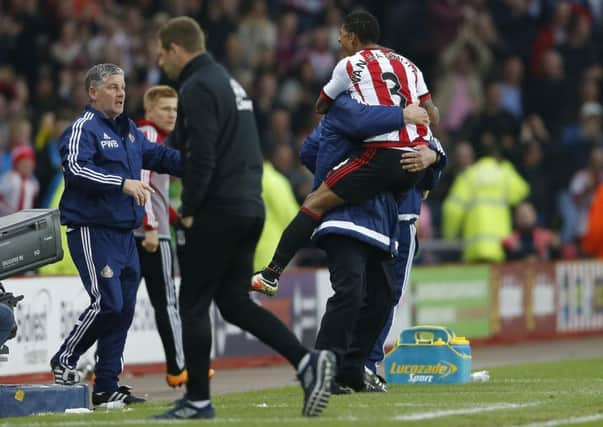How Sam Allardyce brought Sunderland back from the brink of relegation


In his pre-match analysis, Allardyce and his backroom team identified that Everton’s wall all jumped in tandem when defending free-kicks.
Allardyce therefore instructed his set-piece specialists to shoot around the wall, rather than attempt to curl the ball over it, if they were faced with a free-kick within shooting distance.
Advertisement
Hide AdAdvertisement
Hide AdHey presto, van Aanhoolt took that information on board and burst the cloud of anxiety engulfing the Stadium of Light.
It’s an example of Allardyce’s attention to detail and the importance of both statistical and video preparation to the Sunderland boss.
But when Allardyce arrived at the Stadium of Light last October, the conclusions of the number-crunchers alarmed him after discovering that the players he had inherited were the least fit in the Premier League.
That infamous accolade won’t necessarily come as a surprise to supporters who witnessed those harrowing opening two games against Leicester and Norwich.
Advertisement
Hide AdAdvertisement
Hide AdDick Advocaat’s greatest failing was the inability to get the Sunderland squad in shape, albeit he wasn’t helped by the prearranged pre-season trip to North America.
Players were privately admitting that they were “under-cooked” in those first weeks of the season, which instantly banished the day-dream that this campaign would be different to the struggles of previous years.
Allardyce didn’t have a choice, he had to get Sunderland fitter. He encountered grumbles from some and risked injuries to the elder statesmen of the squad by pushing them too hard, but the Black Cats couldn’t afford to be constantly left out of breath.
“It didn’t matter how good we were technically, we were always going to falter because we couldn’t match the opposition in their physical output,” said Allardyce.
“That was the first challenge for the staff.
Advertisement
Hide AdAdvertisement
Hide Ad“We had a few problems in the early stages because the players see it as a punishment.
“But when you show them that they’re not fit enough compared to the rest of the Premier League, they accept that.”
Improved fitness wasn’t alone in keeping Sunderland in the Premier League though and neither was Allardyce’s rigorous defensive drills on the training ground to improve a back-line which at that stage was the worst in the division.
After an initial resurgence under Allardyce, five successive December defeats left Sunderland with just 12 points from the opening 19 games.
Advertisement
Hide AdAdvertisement
Hide AdAt that stage, the halfway point of the campaign, Sunderland were seven points adrift of safety and facing a make-or-break Stadium of Light encounter against whipping boys Aston Villa to merely give themselves a prayer.
The noises coming out of the club suggested that Allardyce didn’t have a huge pot of gold to turn around Sunderland’s fortunes either. January signings were likely to be limited to a centre-half, right-back and possibly a striker.
Allardyce decided to ditch the safety-first reputation and gamble. He perhaps had little choice.
In order to free up funds on Sunderland’s ludicrously high wage bill, Allardyce decided to take a hatchet job to the existing squad.
Advertisement
Hide AdAdvertisement
Hide AdSteven Fletcher, Sebastian Coates, Costel Pantilimon, Jordi Gomez, Will Buckley and Danny Graham all went after suitable enquiries arrived. There was a sense that more could have gone if there had been the interest.
Allardyce’s reshuffle paid instant dividends... well, if Jan Kirchhoff’s miserable debut off the bench at Spurs is put to one aside.
From the moment Kirchhoff, Lamine Kone and Wahbi Khazri lined up together for the first time in February’s 1-0 defeat to Manchester City, Sunderland were a team transformed and they maintained that consistently throughout the run-in.
Allardyce’s men became far more defensively resilient and Jermain Defoe began to do what he does so well – 11 of his 15 Premier League goals coming in 2016.
Advertisement
Hide AdAdvertisement
Hide AdIt wasn’t merely on the pitch that there was a seismic shift either.
The ability and personality of the new boys lifted the mood of a dressing room which had been down in the dumps for months, as they fretted over this year being THE year when Sunderland’s luck would run out.
On the back of a four point haul against Manchester United and Liverpool, the narrative shifted to one of persistent confidence that Sunderland would be okay.
Allardyce said: “I needed to make a dramatic change and to jolt and kick-start the football club into saying ‘this is not acceptable’.
Advertisement
Hide AdAdvertisement
Hide Ad“Whoever has suffered the consequences has suffered the consequences.
“If somebody wanted a player, then he was out. It shifted the wages for me to bring players in.
“We had to get them out, even if it was only on loan, to bring some fresh blood in.
“Wahbi, Lami, Jan and Dame (N’Doye) all came in with a smile on their face; all came in showing the delight that they’d be chosen by a Premier League football club.
Advertisement
Hide AdAdvertisement
Hide Ad“Their excitement lifted the dressing room, which had a ‘here we go again’ mood.
“It was a pretty downbeat dressing room at the time, but they came in and lifted it.
“They had waited so long to play in this league and were so happy to be here.
“The quality of those players lifted the other players that were here as well.
Advertisement
Hide AdAdvertisement
Hide Ad“They saw how good the players were and went ‘wow, this will give us a chance’.”
Khazri, Kone and Kirchhoff will remain the spine of the Sunderland line-up next season as Allardyce aims to end the club’s pattern of annual struggles.
Now his challenge is to find a few more from that mould.